
A Manhattan is a cocktail made with whiskey, sweet vermouth, and bitters. While rye is the traditional whiskey of choice, other commonly used whiskies include Canadian whisky, bourbon, blended whiskey, and Tennessee whiskey. The cocktail is usually stirred then strained into a cocktail glass and garnished traditionally with a maraschino cherry. A Manhattan may also be served on the rocks in a lowball glass.
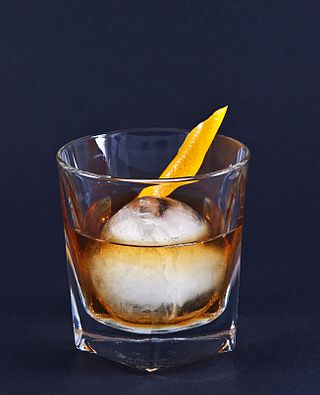
The old fashioned is a cocktail made by muddling sugar with bitters and water, adding whiskey, and garnishing with an orange slice or zest and a cocktail cherry. It is traditionally served with ice in an old fashioned glass.

The martini is a cocktail made with gin and vermouth, and garnished with an olive or a lemon twist. Over the years, the martini has become one of the best-known mixed alcoholic beverages. A popular variation, the vodka martini, uses vodka instead of gin for the cocktail's base spirit.
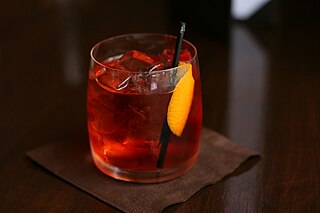
A Negroni is an Italian cocktail, made of one part gin, one part vermouth rosso and one part Campari, garnished with orange peel. It is considered an apéritif.
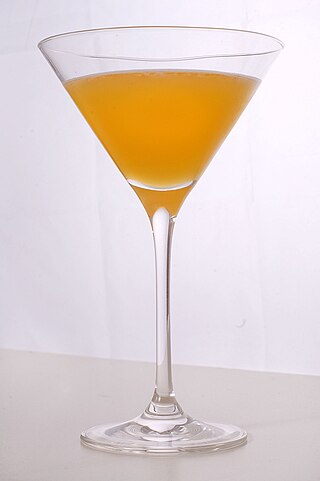
The Bronx is a cocktail. It is essentially a Perfect Martini with orange juice added. It was ranked number three in "The World's 10 Most Famous Cocktails in 1934" behind the Martini (#1) and the Manhattan (#2). In the 1934 movie "The Thin Man", the lead actor compared the methods for shaking the Manhattan, the Bronx and the Martini.

The Fine Art of Mixing Drinks is a book about cocktails by David A. Embury, first published in 1948. The book is noteworthy for its witty, highly opinionated and conversational tone, as well as its categorization of cocktails into two main types: aromatic and sour; its categorization of ingredients into three categories: the base, modifying agents, and special flavorings and coloring agents; and its 1:2:8 ratio for sour type cocktails.
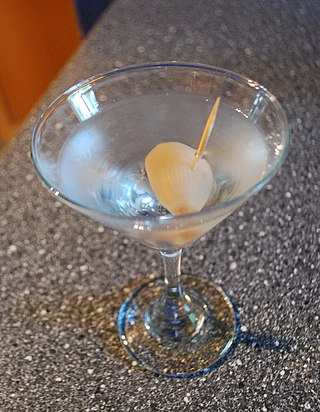
The Gibson is a mixed drink made with gin and dry vermouth, and often garnished with a pickled onion. In its modern incarnation, it is considered a cousin of the ubiquitous martini, distinguished mostly by garnishing with an onion instead of an olive. But the earliest recipes for a Gibson – including the first known recipe published in 1908 – are differentiated more by how they treat the addition of bitters.

The Pegu Club or the Pegu is a gin-based cocktail that was the signature drink of Burma's Pegu Club. Located just outside Rangoon, the club was named after the Pegu, a Burmese river, and its members were those Britons who were senior government and military officials and prominent businessmen.
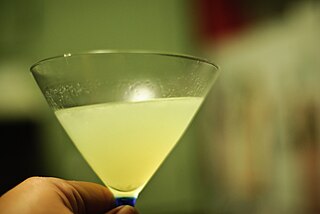
The last word is a gin-based Prohibition-era cocktail originally developed at the Detroit Athletic Club. While the drink eventually fell out of favor, it enjoyed a renewed popularity after being rediscovered by the bartender Murray Stenson in 2004 during his tenure at the Zig Zag Café and becoming a cult hit in the Seattle area.
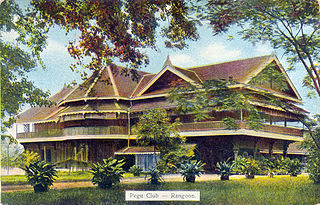
Pegu Club is a recognized heritage site in Yangon, Myanmar, which was a Victorian-style Gentlemen's club founded in 1871 during the British colonization of Burma. The building was built in 1880 and finished in 1882. Pegu Club used to be a place for British officials to spend their time for a drink or two. It was well known because of its signature Pegu Club Cocktail. In southeast Asia, Pegu Club was an equivalent place to the Royal Selangor Club of Kuala Lumpur and The Tanglin Club of Singapore. Rudyard Kipling, as a young newspaperman, visited Pegu Club when he was in Yangon in 1889. Paul Theroux visited Pegu Club in the early 1970s and wrote about it in his book The Great Railway Bazaar. The first phase of the Pegu Club's restoration was completed in 2018.

Mr. Boston Official Bartender's Guide is a cocktail recipe book and bartending manual first published in 1935. The guide was once used on nearly every bar shelf in the United States. About 11 million copies were printed in 68 editions, as of 2015.
The Blackthorn is an Irish whiskey or sloe gin based cocktail. Both versions emerged in the late 19th and early 20th century.

The Martinez is a classic cocktail that is widely regarded as the direct precursor to the Martini. It serves as the basis for many modern cocktails, and several different versions of the original exist. These are generally distinguished by the accompaniment of either Maraschino or Curacao, as well as differences in gin or bitters.

A Nick & Nora glass is a stemmed glass with an inverted bowl, mainly used to serve straight-up cocktails. The glass is similar to a cocktail glass or martini glass.
Audrey Saunders is an American bartender, considered one of the world's most famous bartenders and New York's most famous female bartender.

The craft cocktail movement is a social movement spurred by the cocktail renaissance, a period of time in the 21st century characterized by a revival and re-prioritization of traditional recipes and methods in the bar industry, especially in the United States. The renaissance spanned from 2004 into the late 2010s. By 2017, high-quality ingredients, techniques, and liquors began to be ubiquitous in bars across the United States, leading writers to declare the renaissance over.
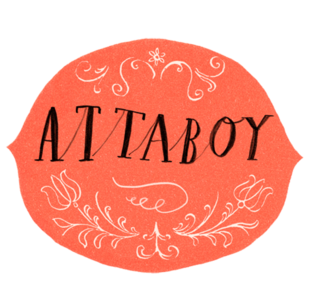
Attaboy is a craft cocktail bar in the Lower East Side of New York City.
Bemelmans Bar is a cocktail and piano bar in the Carlyle Hotel, on the Upper East Side in Manhattan, New York City. The bar opened in the 1940s, serving wealthy Upper East Siders and numerous celebrities. Bemelmans has distinctive Art Deco decor, including murals of Madeline painted by Ludwig Bemelmans, author and illustrator of Madeline. It has been known for multiple drinks, though in recent years it is best known for its martinis, often served very dirty.

















